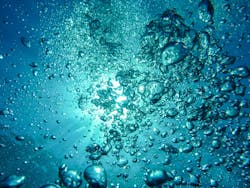3D Printing in Water—A Tissue Engineering Game Changer?
3D printing using semiconductor hybrid nanoparticles is slated to help grow bio-degradable implants, hydrogels, and bioscaffolds by enabling the use of aqueous substrates similar to the ones found in our bodies. It could improve the survival time of proteins and cellular matrices needed to support cell growth in tissue engineering, and can be done at low-energy light frequencies that are not ionizing for live cells.
In the image, a “bucky ball”—or a spherical geometry of a hexagonal lattice—is featured as a final printed design.
The semiconductive nanoparticles are tiny rods with metal tips, making them photo-initiators (image a). Photoiniators are needed for radical photopolymerization—a curing process that creates polymers from a liquid in the presence of light. Photopolymerization is a common curing technology used in a wide variety of 3D printing applications.
When excited by light, photoiniators such as the HNPs create free radicals, or atoms with an unpaired electron, that react with atoms in the 3D printed ink to cause polymerization. These HNPs in particular form hydroxyl radicals. They can be used in water because they are water soluable and they consume dissolved oxygen—which has been a common inhibitor for printing in water.
Radical photopolymerization is a curing process that uses energy from UV light to make a photoiniator less stable. After being excited by light, the photoiniator may produce a free radical (unpaired electron) or ion that acts as an intermediate component in polymerization. Polymerization is the bonding between monomers to build molecular chains.
The photoinitator ink eliminates the need for additional organic solutions and solvents that raise health and environmental concerns, and is also excited by a wide spectrum of UV and visible light that is below the normal, ionizing range of 200 to 350 nm. They possess tunable properties as well. Since the nanoparticles are excited by just 2 photons, the team could use a 2-photon printer to create high-resolution features (image c).
The research is published by a team from the Hebrew University of Jerusalem in Israel and the University of Maryland in the U.S. in the journal Nano Letters. The paper is called Rapid Three-Dimensional Printing in Water Using Semiconductor–Metal Hybrid Nanoparticles as Photoinitiators.
About the Author
Leah Scully
Associate Content Producer
Leah Scully is a graduate of The College of New Jersey. She has a BS degree in Biomedical Engineering with a mechanical specialization. Leah is responsible for Machine Design’s news items that cover industry trends, research, and applied science and engineering, along with product galleries. Visit her on Facebook, or view her profile on LinkedIn.

